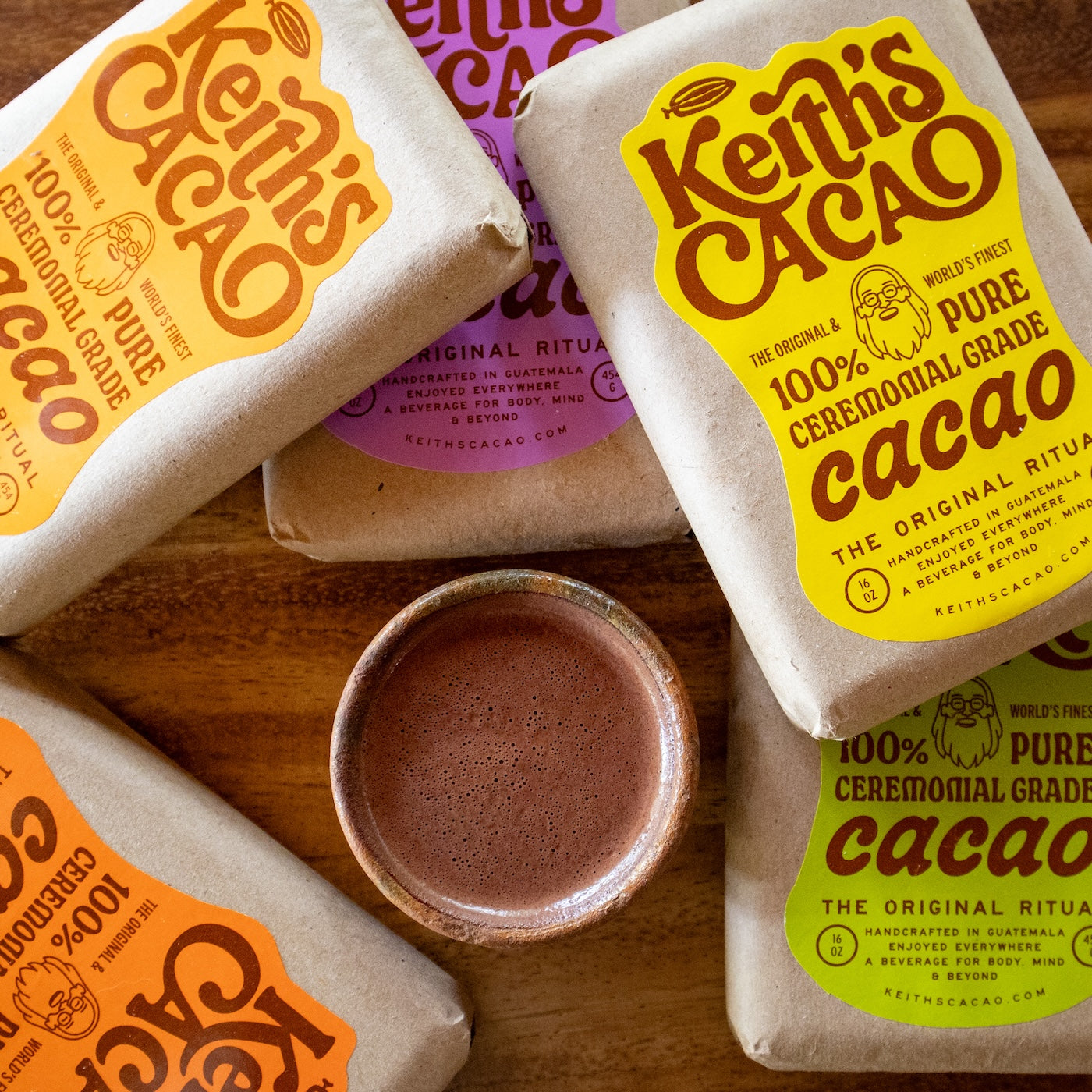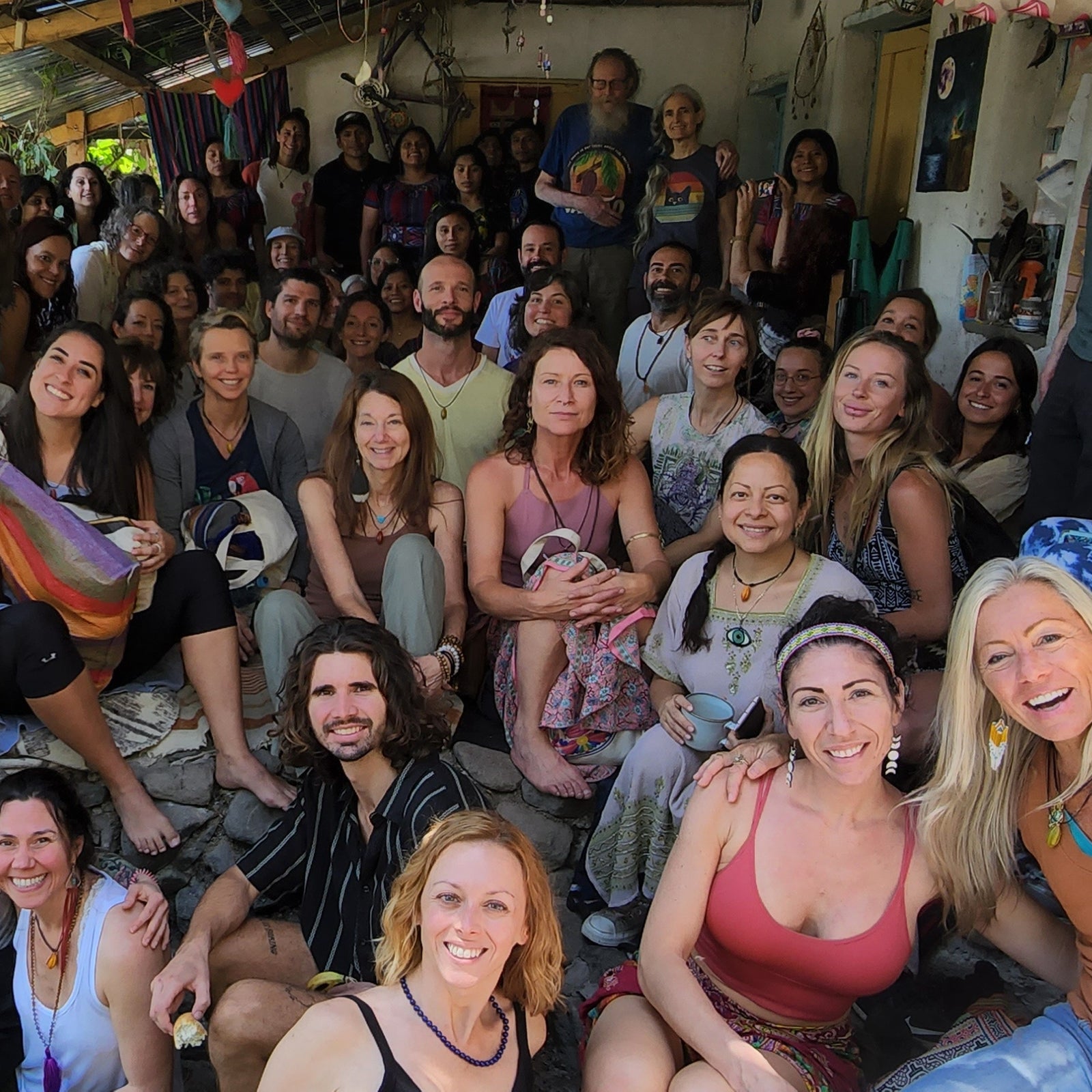Cacao beans | Ceremonial cacao | Keith's original writings | Keith's wisdom
The Making of Keith's Cacao
This blog post is an excerpt from the original writings of Keith Wilson, the Chocolate Shaman, first published in 2012. For more recent info on all things Ceremonial Cacao, visit our main blog For the Love of Cacao.
"Fall in love with the Earth; it's the only planet with chocolate!" - Keith Wilson
The Food of the Gods… The Food for the Shift
Keith's Cacao is harvested, fermented, and dried in Guatemala's virgin Pacific coastal rainforest mountains by local Mayan people. Some thirty-plus years ago, roads were bulldozed into these mountains to remove the select, highly-prized hardwood species, leaving the canopy and original soils intact. The booming indigenous population then used this access to underplant with coffee, bananas, and Cacao – that's typical of the coastal virgin rainforests where these still exist; they are relatively untouched only in remote high-slope areas. On old 1700s botanical maps of the native cacao-growing regions of Central America, the largest areas indicated are in Pacific Guatemala, where Keith's Cacao comes from. This is also the region that the ancients considered to produce the best ceremonial Cacao, and they fought over it repeatedly.
When I need Cacao, the Cacao Deva (consciousness/Spirit behind the form) guides me on where to get the beans with the compounds and energy best suited for my work. That's the only 'certification' I need. I have walked into the mountains, steamy coastal-plain towns on market day, and city wholesale markets. Over the last several years, I have been buying Cacao, several hundred to thousands of kilos at a time. Every trip for Cacao is an adventure.
After some nibbling, feeling the energy, and communicating with the Cacao Deva, I almost always buy the small-seeded, native Criollo variety that has been used for spiritual purposes by indigenous peoples for millennia.
The Traditional Fermentation Process
Cacao goes through a fermentation process before it leaves the farm where it is grown. First, the fresh ripe pods picked from the trees are split open. The 30-50 cacao beans in each pod, together with the sweet-tart white pulp that surrounds them, are piled in a wooden box with drain holes, a porous bag, or in a hole dug in the rainforest floor that is lined and covered with banana leaves. The natural yeasts and bacteria present in the air get on this sugary pulp and begin to grow. The yeast converts the sugar into alcohol, and in the presence of oxygen, the bacteria reduce the alcohol to vinegar.
Cacao is both a fermented and sprouted food. The seeds first sprout and then die in the last phase of fermentation, where the temperature often rises to 125°F (52°C), exceeding the limit set by raw advocates. In this sense, almost all of the 'raw' Cacao is not raw. When the pulp has fully liquefied and drained away, the seeds are laid out to dry in the sun (or sometimes in the shade). Drying lowers the moisture content and completes the oxidative process, but it is the roasting that produces the chocolate-specific aroma and flavor. Without the roasting, it wouldn't taste like chocolate, just like it's the roasting that gives coffee its flavor and aroma.
Cacao fermentation has been extensively studied and found to significantly affect the active compounds responsible for the chocolate flavor's richness and the final product's energetic potency. The hybrid varieties that comprise 90-95% of the world's production have a thick pulp and require 5-7 days to ferment, giving rise to such high temperatures that the beans get too hot to touch. The thin-pulped native Central American variety we use has a thin pulp, fermentation takes 2-3 days to complete, and the beans do not get nearly as hot. By the way, if you carefully break open a dry cacao bean, you will find a tiny wooden stick about 3-4 millimeters long; that is the dried sprout.
Cacao beans need soaking or toasting/roasting to allow for the removal of the husk, the almond-like papery skin. To ensure full potency, our beans are traditionally processed with just a quick, light toasting over wood-fired stoves, then individually hand-peeled by about 15 families of Kaqchikel Mayan women, an indigenous community right here in San Marcos, in their own homes at their own pace. These women are paid directly, and this is the only independent income they have. They are paid by bean weight before peeling, so they have no incentive to include poor-quality beans. And they are paid well not to over-roast, a standard practice for easy peeling/machine processing. There is very little hand-peeled Cacao on the market, but I like a good product!
The Importance of Hand-Peeling
Hand-peeling means that the moldy beans, which in the occasional batch are more than a few, are removed instead of being incorporated as nibs by a machine. For me, this is an essential consideration with this traditionally sourced Cacao. I could save time and money by machine-processing everything into nibs, but then I'd be drinking and selling that mold. Besides, the moldy beans are fed to the Mayan chickens, and the eggs they lay are so rich! The returned peeled beans are then sorted again in our workshop on specially designed white trays to remove any more poor beans and other contaminants - I know what is in Cacao, and you don't want to be drinking it! No other cacao processors that I know of do this extra sorting. They just grind it all up!
I have been in communication with the Cacao Deva about raw preparation and have experimented for years. As I understand it, She suggests fermenting and toasting/ roasting for husk removal. Light toasting is better for the body and is what shamans have traditionally been doing for thousands of years. Since traditionally, Cacao is dried on the ground, there can be surface bacteria and molds. Light toasting is the simplest way of killing off the bacteria and is the only way I'll peel. This quality of Cacao produced and prepared this way works for us and the metaphysical work that we do. Sourced from non-hybridized and non-plantation understory trees in an ancient tropical rainforest on original soils, then processed in the old way with hand-peeling - this is straight-up traditional Cacao.
The answer I got from the Cacao Spirit was this: Why would you want to do it differently from what the shamans have been doing for thousands of years? Live bean sprouting during small-batch low-heat fermentation, sun drying, light toasting, and hand peeling. Do you believe the shamans did not know what they were doing, that the sprouting, fermenting, and toasting was not better for the human body and for consciousness purposes than any other way of production?
'Raw' Cacao
Real raw Cacao is found only in the rainforest and as whole pods at the market. And it doesn't taste anything like chocolate! Cacao is only truly raw when the entire pod content -pulp, seeds, and husk- is dehydrated before fermentation progresses very far. These are rainforest seeds; drying kills them. Other Cacao, fermented or not, is wet-peeled without roasting.
Almost all of the 'raw' nibs (plus the 'raw' cacao powder derived from them after hot hydraulic pressing at 200°F/93°C) have been roasted at very high temperatures. Otherwise, machine-peeling doesn't work. Although the truth about the 'raw' scam has made the rounds, most raw foodies would rather be lied to than know the facts. Our Cacao is toasted enough to hand-peel but not enough to be efficiently machine-processed into nibs. When we visited a small Guatemalan chocolate factory with a friend, he was shocked that the bean roaster was so hot he couldn't get close to it.
The Cacao Spirit tells me that eating real raw Cacao straight from the trees in the rainforest or at the market is fine, but only on occasion; and I do. However, She recommends fermentation, light-toasting, and husk removal for regular consumption, as is the tradition. As is quite common with many seeds, the husks/skins contain toxic compounds to keep rainforest beasties from eating the beans. I know of large, otherwise conscientious, raw chocolate makers in the USA that, under the pretext of being more 'natural' but also simply to avoid the expense and weight loss (15-20%) of peeling, finely conch the entire bean, husk and all. Before you consume this chocolate on a regular basis, I suggest you check in with yourself or with the Cacao Spirit. Or, if you are lodged in the rational mind, look up common husk toxins -ochratoxin, patulin, and penicillic acid- on the web. Also, do some research on the harmful bacteria and pathogens common in whole Cacao beans. That is why the Cacao Spirit suggests that, though commonly sold, Cacao husk tea is not suitable for consumption.
The Cacao Deva also prefers the small-seeded, wild varieties we use, and the 2-3 days fermentation process to the higher temperature 5-7 day fermentation required for large-seeded South American varieties (like the Arriba Nacional Cacao from Ecuador so favored by some raw sellers). Because of the varieties and the processing, our Cacao ends up being anywhere between 10-80% stronger than the best of the South American or the Indonesian hybrid version widely sold as raw Cacao.
Don't let the pictures of the Ecuadorian or Peruvian raw sellers, proud of their giant easy-peeling Cacao beans, fool you. These come from varieties hybridized by colonists a few hundreds of years ago and from varieties with a thick pulp requiring much longer fermentation, bred over millennia as a fruit snack. In addition, the most commonly available South American and southern Central American varieties have much higher caffeine content, making them too buzzy for inner work. There is a famous spiritual community in Costa Rica that consumes a lot of Cacao, and they are caffeine cranked. As many office workers understand, caffeine fosters aggression. Moreover, independent lab testing has shown that almost all Peruvian Cacao has higher cadmium (a toxic heavy metal) levels than the legally accepted percentage for import into the EU or California.
If using 'raw' nibs (broken pieces of Cacao bean), measure out the same amount of Cacao or more since most Ecuadorian, Peruvian, Brazilian, Indonesian, and African nibs are 15-70% weaker than our Guatemalan Cacao. You will have to blend the nibs (in a blender) with a small portion of the water or else chew them finely, as bean fragments do not melt in hot water. If you are using finely powdered raw Cacao, try half the amount, as most of the butter weight has been removed through hot hydraulic pressing. The 'raw' powder is much more variable in ceremonial suitability than the nibs. Try it for yourselves. You can also expect such hybrid Cacao varieties to have a lot of caffeine, which, in our experience, can become too 'buzzy' with no focus.
Enjoy this sacred Food for the Shift – The Holy Bean!
For more of Keith's wisdom, visit Keith Wilson's Original Blog on Keith's Cacao Blog Directory.

